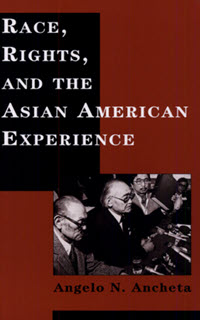Abstract
Excerpted from: Harvey Gee, Race, Rights, and the Asian American Experience: A Review Essay, 13 Georgetown Immigration Law Journal 635 (Summer, 1999) (Book Review: Race, Rights and the Asian American Experience by Angelo N. Ancheta, Rutgers University Press, PP. 209 (1998)) (82 Footnotes) (Full Document)
 As a movement for social change, Asian American activism must confront institutional forces that maintain the status quo. Asian American movements face additional burdens that stem from society's refusal to acknowledge the oppression, humanity, and the very existence of Asian Americans.
As a movement for social change, Asian American activism must confront institutional forces that maintain the status quo. Asian American movements face additional burdens that stem from society's refusal to acknowledge the oppression, humanity, and the very existence of Asian Americans.
Ancheta's book represents one of the most comprehensive and insightful contributions by a new generation of Asian American scholar-activists, striving to bring the discourse about race and the law beyond the traditional black and white racial scheme. As Angelo Ancheta notes in the introduction to his new book, Race, Rights, and the Asian American Experience, “[p]opular works on race suggest that expositions of Asian American experiences are peripheral, more often confined to the footnotes than expounded in the primary analyses.” In addition, he claims that “[p]ublic policies that reflect and reinforce race relations also approach race in terms of black and white.” Ancheta is correct. By including Asian Americans in the national conversation about race, Ancheta's book is valuable in explaining why race should not be considered, literally or figuratively, a black and white matter.
In building upon earlier works by Asian American legal scholars and Critical Race Theorists, Ancheta condenses a decade's worth of scholarly work into two-hundred and nine pages, to present a compelling book which is undoubtedly a must-read for all. Unlike other recent legal writings by Asian American scholars, Ancheta's book avoids a strictly theoretical analysis by offering realistic recommendations and pragmatic alternatives for changes in both legal doctrine and for general approaches to race relations. For example, one such recommendation is Ancheta's innovative use of transracial rights remedies. According to Ancheta, we should place civil rights and remedies in a transracial framework to create remedies that accommodate racial differences without forcing a zero-sum solution which would pit one racial group against another.
The remainder of Ancheta's book is a very comprehensive summary of the Asian American experience and the legal, political, and social issues that have affected Asian Americans. Interestingly, Ancheta draws heavily from his professional experiences in heading the Asian Law Caucus, a non-profit civil rights organization in San Francisco, and his personal experiences as a Filipino American, in order to demonstrate that a broader perspective on race jurisprudence is possible. Ancheta's analytical framework utilizes history, social science data, and personal anecdotes to illustrate how Asian Americans continue to face discrimination, even as they continue to gain social and economic mobility. His summary begins with the legal challenges against Chinese immigrants during the mid-nineteenth century and ends with an analysis of the recent English Only laws.
In examining Race, Rights, and the Asian American Experience, this essay is divided into five parts.
Part II examines the inadequacy of the black/white paradigm of race relations. Ancheta's work is crucial in demonstrating how and why the inclusion of Asian Americans widens the dynamics of the national dialogue on race. This section suggests that racial hierarchies and intergroup conflicts require new theories of race relations that move beyond the current black/white dichotomy.
Part III reviews sections of Race, Rights, and the Asian American Experience and explores the social construction of Asian American identities in the postmodern era. Those sections make the case that anti-Asian subordination is distinct from anti-black subordination. The book suggests that unlike color-based subordination, which divides racially between the superior and the inferior, anti-Asian subordination is centered on citizenship, which creates a racial divide between the American and the foreigner.
Part IV examines the new nativist backlash against Asian immigrants.
Part V concludes by addressing the place which Race, Rights, and the Asian American Experience stakes out within the emerging Asian American legal scholarship movement. Each part is significant in understanding the history and effects of racial discrimination against Asian Americans and the powerful influence of race and color-consciousness in American society. Lastly, this essay uses Ancheta's book as a foundation to make the argument that: understanding the Asian American experience is crucial to recognizing the racial hierarchy that exists in this country.
. . .
As American society moves into the next century, our discourse on race must expand dramatically to include both racial and transracial thinking. What is needed is not a homogenous, color-blind system of racial values, but [rather] a set of core values that recognizes and appreciates differences, both racial and nonracial.
In short, Ancheta's books is an ambitious, well-written, and unprecedented compilation of the legal theory, history, and personal narratives of Asian Americans. Moreover, the breadth of Ancheta's analysis goes beyond Asian Americans, and the theories he expounds could be relevant to anyone interested in racial justice. Ancheta's contribution will undoubtedly serve as a basis for a new and more sophisticated national dialogue about race. Hopefully, Ancheta's book will persuade readers that in order for race relations to advance, it is necessary to include people from all ethnic backgrounds in the discussion on race relations. Lastly, this tremendous work will encourage readers to critically examine and evaluate their own views about the increasing importance of race relations in our society today.
B.A., Sonoma State University, 1992; J.D., St. Mary's University School of Law, 1998; LL.M., The George Washington University School of Law, 1999.


